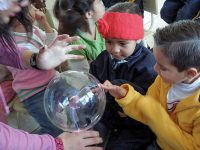
Illustration: Hugo Salais
They say humans imitate animals, and we certainly did when we were young during the scorching hot months of the summer, although we did not sip our lemonade with elephant trunks or butterfly tongues, but with a straw. It seems that the Sumerians already used them to drink beer, to avoid the dregs, like Argentinians drinking yerba mate. At the time, I was not aware that our infant mouth was playing with a sort of eyedropper or laboratory pipette, and its effects were similar to those of the syringe my practitioner used to extract the antibiotic to treat my frequent tonsillitis. But I would never have imagined that it had anything to do with those iron cranks that people used to pump water up and down in Westerns.
In his famous Discorsi, Galileo uses Sagredo’s mouth to say what all well makers already knew: it is impossible to raise water more than 10 meters with a plunger pump. In other words, if I am on a second floor and I want to drink water from a glass placed on the sidewalk, I can do it by sucking through a sufficiently long straw. But if I am on the fourth floor, even if I was to lengthen the straw, the water column would not go beyond 10 meters, and it would not reach me. Using my mouth, a syringe, or a suction pump would make no difference.
«Several of Galileo’s disciples, especially Torricelli, understood that the air around us is heavy and exerts a pressure on us»
Several of Galileo’s disciples, especially Torricelli, understood why: even if we do not realise it, the air around us is heavy and exerts a pressure on us. When I suck, I decrease the pressure at that end of the straw. The pressure of the outside air, which is greater, is transmitted to the water in the glass, which pushes up through the straw… But how far? This is an alternative way to verify it: fill a bottle or test tube with water, cover it with your fingers, turn it upside down, and uncover it after putting the neck in a bowl with water. We will see that the water remains, the bottle remains full despite being upside down. The same would happen with a taller bottle. I would need a gigantic bottle (about 10.2 m high) to see the water descend, and a column of about 10 m would remain. For this height (with equal area) the weight of the water column in the bottle and the weight of the outside air are identical. If, like Torricelli, we used mercury (fourteen times as dense as water), the height would need to be 0.75 m; this would be more practical as a barometer: if the air pressure increases, the level increases (sustaining a larger column); if it decreases, the level drops. Pascal is said to have conducted one of the most famous public experiments of the time, using red wine (was would it be Burgundy or Bordeaux?): the wine column was higher than the water column. This crucial result won him a bet against the peripatetics. But that is a different story.
The suction pump preserved in the Spanish National Archaeological Museum (MAN) puzzles visitors. It could be a bilge pump from a ship from Lepanto, or belong to a Dutch dam mill from the Spanish Golden Age, or to a twentieth-century Balearic water mill. However, it was used in the first century BCE in the Sotiel-Coronada mine (Huelva, Spain). Its invention is attributed to Ctesibius and it is included in Hero of Alexandria’s treatise, together with other pneumatic and hydraulic machines. We use a similar device when we squeeze the liquid soap dispenser or we pistol spray a cleaning product.
Summer, swimming, freedom, laughter. «Don’t make a mess», they tell us, while we play with the lemonade remains. Raising and lowering the water, stopping it at will, ejecting it like a fountain. All with a simple straw.
|
TRY IT: Using simple materials like plastic bottles, straws, modelling clay, and syringes you can witness many interesting phenomena relating to air and water pressure. 1. Empty a plastic water or juice bottle a little, introduce a straw and suck (until the liquid reaches your mouth). Now, pierce the straw near the top end. Cover and uncover the hole and suck in both cases. What happens? 2. Pierce the cap of the bottle to let the straw through, and fill any cracks with modelling clay. Close the bottle and suck it out. Does the liquid reach your mouth? Why? 3. Turn the bottle filled with water upside down over a bowl as explained in the text. Do the same with a larger bottle. Does it change anything? 4. Fill a glass with water, put a piece of cardboard on top to cover it and invert the glass. Let go of the cardboard. What happens now? |





